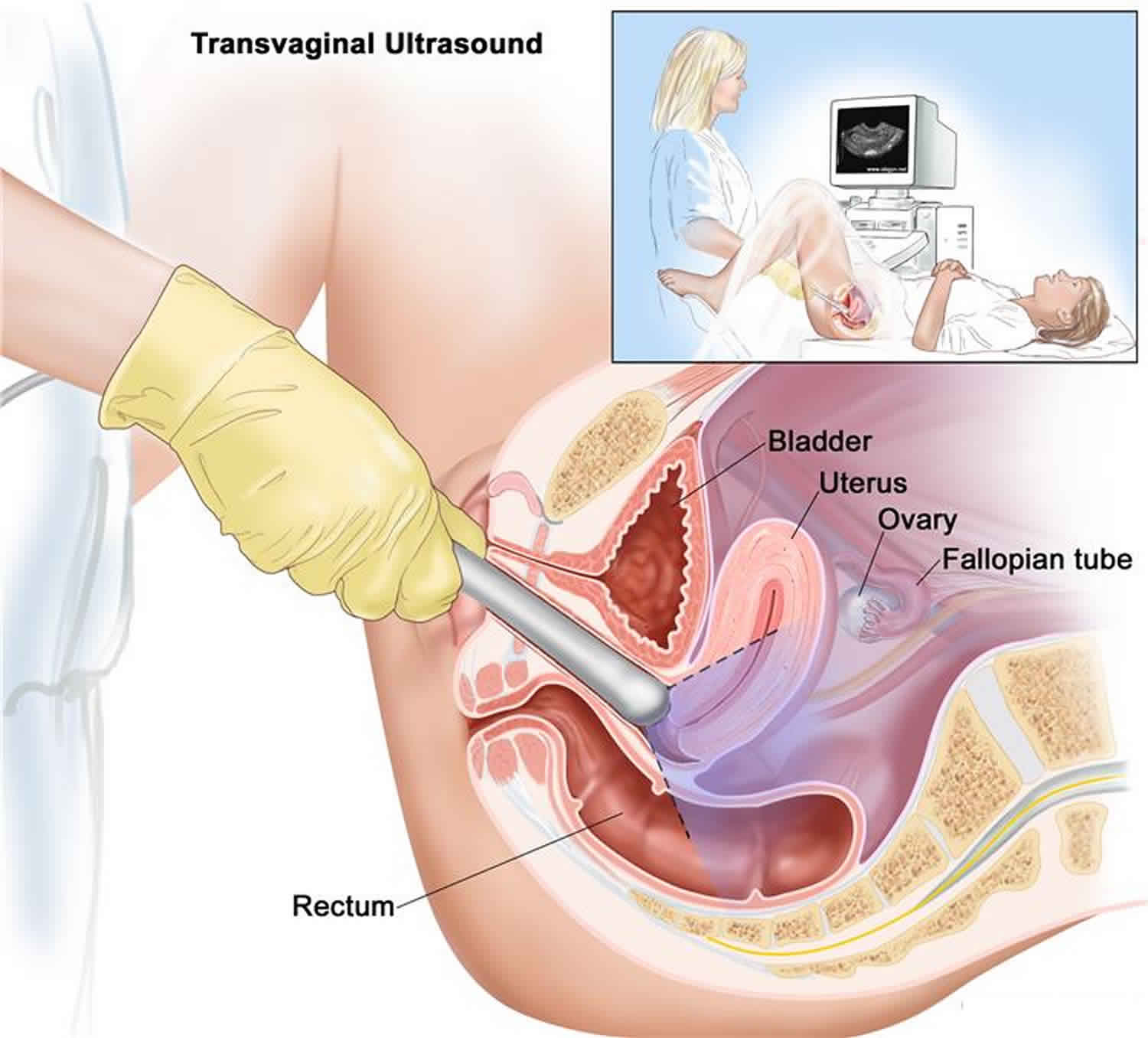What is a transvaginal ultrasound
A “transvaginal” ultrasound means “through the vagina”. The ultrasound probe will be placed inside the vagina. During the transvaginal ultrasound procedure, you’ll be asked to either lie on your back, or on your side with your knees drawn up towards your chest. A small ultrasound probe with a sterile cover, not much wider than a finger, is then gently passed into the vagina and images are transmitted to a monitor. Transvaginal ultrasound is a test used to look at a woman’s uterus, ovaries, fallopian tubes, cervix, vagina, urinary bladder and pelvic area.
Transvaginal ultrasound is a method of imaging the genital tract in females. A hand held probe is inserted directly into the vagina. The probe is moved within the vaginal cavity to scan the pelvic structures, while ultrasound pictures are viewed on a monitor. Transvaginal ultrasound can be performed to evaluate women with infertility problems, abnormal bleeding, sources of unexplained pain, congenital malformations of the uterus and ovaries, and possible tumors and infection.
The ultrasound technician or doctor will introduce a probe into your vagina. It may be mildly uncomfortable, but will not hurt. The probe is covered with a condom and a gel.
- The probe transmits sound waves and records the reflections of those waves off body structures. The ultrasound machine creates an image of the body part.
- The image is displayed on the ultrasound machine. In many offices, the patient can see the image also.
- The ultrasound technician or doctor will gently move the probe around the area to see the pelvic organs.
In some cases, a special transvaginal ultrasound method called saline infusion sonography (SIS) may be needed to more clearly view the uterus.
How the transvaginal ultrasound is performed
You will be asked to undress, usually from the waist down. A transvaginal ultrasound is done with your bladder empty or partly filled.
You will lie down on your back on a table with your knees bent. Your feet may be held in stirrups.
Transvaginal ultrasound is performed very much like a gynecologic exam and involves the insertion of the transducer into the vagina after you empty your bladder. The tip of the transducer is smaller than the standard speculum used when performing a Pap test. A protective cover is placed over the transducer, lubricated with a small amount of gel, and then inserted into the vagina. Only two to three inches of the transducer end are inserted into the vagina. The images are obtained from different orientations to get the best views of the uterus and ovaries. Transvaginal ultrasound is usually performed with you lying on your back, possibly with your feet in stirrups similar to a gynecologic exam.
Does a transvaginal ultrasound hurt?
Transvaginal ultrasound may cause mild discomfort from the pressure of the probe, but don’t usually cause any pain and shouldn’t take very long. Only a small part of the probe is placed into the vagina.
Transvaginal ultrasound is usually more comfortable than a manual pelvic examination or gynecologic examination.
Why is transvaginal ultrasound performed?
Transvaginal ultrasound may be done for the following problems:
- Abnormal findings on a physical exam, such as cysts, fibroid tumors, or other growths
- Abnormal vaginal bleeding and menstrual problems
- Certain types of infertility
- Ectopic pregnancy
- Pelvic pain
Transvaginal ultrasound is also used during pregnancy.
Transvaginal ultrasound in pregnancy
A pregnancy ultrasound is an imaging test that uses sound waves to create a picture of how a baby is developing in the womb. It is also used to check the female pelvic organs during pregnancy.
Transvaginal ultrasound is more likely done in early pregnancy, many women will have the length of their cervix measured by transvaginal ultrasound around 20 to 24 weeks of pregnancy.
A pregnancy ultrasound may be done during the first 12 weeks of pregnancy to:
- Confirm a normal pregnancy
- Determine the baby’s age
- Look for problems, such as ectopic pregnancies or the chances for a miscarriage
- Determine the baby’s heart rate
- Look for multiple pregnancies (such as twins and triplets)
- Identify problems of the placenta, uterus, cervix, and ovaries
- Look for findings that might indicate an increased risk for Down syndrome
Abnormal ultrasound results may be due to some of the following conditions:
- Birth defects
- Ectopic pregnancy
- Poor growth of a baby while in the mother’s womb
- Multiple pregnancies
- Miscarriage
- Problems with the baby’s position in the womb
- Problems with the placenta, including placenta previa and placental abruption
- Too little amniotic fluid
- Too much amniotic fluid (polyhydramnios)
- Tumors of pregnancy, including gestational trophoblastic disease
- Other problems with the ovaries, uterus, and remaining pelvic structures
What does a transvaginal ultrasound show
A transvaginal ultrasound is usually performed to view the endometrium (the lining of the uterus) and the ovaries. Transvaginal ultrasound also evaluates the myometrium (muscular walls of the uterus). Sonohysterography allows for a more in-depth investigation of the uterine cavity. Three-dimensional (3-D) ultrasound permits evaluation of the uterus and ovaries in planes that cannot be imaged directly. These exams are typically performed to detect:
- uterine anomalies
- uterine scars
- endometrial polyps
- fibroids
- cancer, especially in patients with abnormal uterine bleeding
Transvaginal ultrasound results
An abnormal result may be due to many conditions. Some problems that may be seen include:
- Birth defects
- Cancers of the uterus, ovaries, vagina, and other pelvic structures
- Infection, including pelvic inflammatory disease
- Benign growths in or around the uterus and ovaries (such as cysts or fibroids)
- Endometriosis
- Pregnancy outside of the uterus (ectopic pregnancy)
- Twisting of the ovaries
Transvaginal ultrasound risks
There are no known harmful effects of transvaginal ultrasound on humans. Unlike traditional x-rays, there is no radiation exposure with transvaginal ultrasound.





